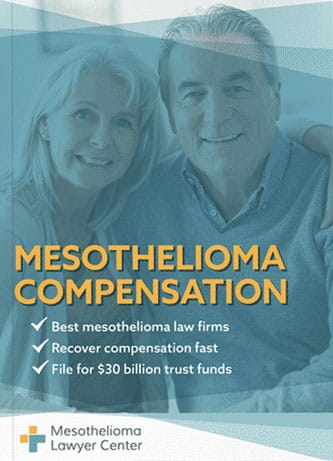Chrysler once manufactured automotive parts with asbestos, exposing workers and home mechanics. A 2009 bankruptcy shielded Chrysler from ongoing asbestos lawsuits, but the company set up a trust to compensate victims. Chrysler is now part of Stellantis.
There is currently more than $30 billion available in asbestos trust funds. If you or a loved one have been diagnosed with mesothelioma, asbestos-related lung cancer, and asbestosis, keep in mind that you may be entitled to compensation. Fill out our form to get a free Financial Compensation Packet. You’ll learn about the experienced mesothelioma lawyers in your area, how to get paid in 90 days, how to file a claim for the asbestos trust funds, and more.


FREE Financial Compensation Packet
- Info on law firms that will recover your HIGHEST COMPENSATION
- Learn how to get paid in 90 days
- File for your share of $30 billion in trust funds

Did Chrysler Use Asbestos?
Like other automotive companies in the 1900s, Chrysler used asbestos in some components for many years. Asbestos is an excellent insulator and fireproofing material. It was useful in cars to prevent overheating from friction and reduce the risks of fires.
Chrysler History
Walter P. Chrysler founded the Chrysler Corporation in 1925 as a reorganization of Maxwell Motor Company in Highland Park, Michigan.
- The company’s first automobile was the Chrysler 6. At a selling price of $1,565, the Chrysler 6 contained four-wheel hydraulic brakes and a six-cylinder engine.
- Chrysler soon acquired Plymouth to offer a lower-cost alternative to the Chrysler 6.
- In addition to making automobiles, the company made replaceable oil filters and windshields. Chrysler bought the Dodge Brothers in the 1930s, adding Dodge brand vehicles to its automotive line.
- During World War II, Chrysler manufactured vehicles for the military. Its factories also produced aircraft engines, air raid sirens, and other equipment for the war effort.
- Chrysler began to struggle during the oil crisis of the 1970s. Americans wanted smaller, more fuel-efficient cars, and Chrysler had a hard time competing with Ford, GM, and Japanese companies. In 1980, Chrysler received a $1.5 billion loan from the federal government.
- In 1998, the Chrysler Corporation Daimler-Chrysler, after partnering with German automaker Daimler-Benz. The company then experienced decades of financial troubles over the next several years, selling its shares.
- In 2007, Cerberus Capital Management bought 80.1% of Daimler’s stake in Chrysler for a little over $7 billion.
- Chrysler filed for bankruptcy in 2009 and received a $6 billion government handout. This led to the creation of a trust that would compensate United Auto Workers (UAW) Chrysler employees. It covered asbestos exposure but only for former Chrysler workers.
Italian automaker Fiat merged with Chrysler in 2014 to create Fiat Chrysler. In 2019, it merged with PSA Group and was renamed Stellantis.
How Did Chrysler Use Asbestos?
Daimler Chrysler was responsible for many asbestos-containing products, often bought from other companies, including disk brakes, linings, and clutches from:
- Bendix Corporation
- Abex Corporation
- BorgWarner
- The Johns Manville Corporation
- Luk, Fichtel & Sachs
- Raybestos-Manhattan
Chrysler manufactured its own drum brake components with asbestos from the 1960s to the 1980s. Automotive parts made or used by Chryser that contained asbestos included:
- Brakes
- Clutches
- Engine components
- Heat seals
- Hoodliners
- Gaskets
- Some body parts
Clutches and brakes contained the most asbestos for the longest period of time throughout the automotive industry. These components were at high risk of overheating due to friction. Asbestos reduced the risk.
Who Was Exposed to Asbestos Through Chrysler Vehicles?
Asbestos automotive parts posed risks to workers because handling them released harmful fibers. Asbestos fibers in the air could easily be inhaled by any workers in the area.
Workers in different occupations were exposed to asbestos via Chrysler’s products, including:
- Brake mechanics and assemblers
- Employees of auto parts and manufacturing stores
- Clutch mechanics and assemblers
- Factory workers
- Machine Operators
- Warehouse workers
Also at risk for exposure to asbestos from Chrysler parts were home mechanics. People who worked on their own vehicles may have removed and replaced clutches and brakes, exposing themselves to asbestos fibers.
Asbestos in Old Chrysler Factories
Shuttered automotive factories in Detroit and other locations pose risks to residents. Many have lingering toxic materials, including asbestos, that can expose anyone living nearby.
One problematic facility belonged to Chrysler and was in use until 2009. The company that purchased the site from Chrysler exposed community members to asbestos and other substances when it scrapped the buildings for copper and other valuable materials.
Chrysler Bankruptcy
In 2009, Chrysler filed for bankruptcy. The U.S. government agreed to provide $6 billion, stipulating that Chrysler partnered with Fiat. Within months, Chrysler emerged from bankruptcy.
Although the company emerged from bankruptcy quickly, it faced numerous asbestos-related claims and lawsuits.
Starting in the early 1980s, Chrysler handled many asbestos-related claims due to manufactured automobile parts that contained asbestos.
Thousands of plaintiffs developed asbestos-related diseases after working around Chrysler’s products or purchasing the products as consumers.
Chrysler Asbestos Lawsuits
Internal documents indicate that Chrysler was well aware of the dangers that asbestos posed yet gave no warnings to workers or consumers.
As a result, the company faced numerous lawsuits and controversies related to asbestos use.
$25 Million for Mechanic
In 2006, a New York County jury awarded Alfred D’Ulisse, 73, $25 million in his lawsuit against Chrysler. D’Ulisse developed malignant mesothelioma after working on asbestos-containing brakes manufactured by Chrysler while working at Brooklyn’s Morak Brakes.
From 1960 to 1964, D’Ulisse stripped linings from worn linings from old brakes and replaced them.
He became a city police officer afterward but still worked part-time at Chrysler during his 36-year employment as a police officer.
Lawyers presented evidence that Chrysler knew about the dangers of asbestos and failed to place warnings on its products.
The jury found that the defendant was 10% liable for damages. Still, because it acted “with reckless disregard for the safety of others,” the company was responsible for the full verdict amount.
Before developing mesothelioma, D’Ulisse was an active participant in his grandchildren’s lives and in several sports, including baseball, paddleball, dancing, and handball. Yet, the symptoms of his disease were so severe that he could no longer enjoy any activities.
Chrysler Exhibits Poor Conduct During Mesothelioma Victim’s Burial
In 2009, Harold St. John, 67, filed an asbestos-related lawsuit against Chrysler. St. John said he developed malignant mesothelioma due to working with Chrysler brakes. St. John passed away before his trial began.
According to court documents, Chrysler sent one of its representatives to St. John’s funeral service to stop him from being buried.
The Chrysler representative ordered St. John’s body to be taken back to the funeral home to perform an autopsy.
Superior Court Judge Phillip denied Chrysler’s request for an autopsy based on St. John’s family’s objections.
Chrysler appealed and ordered a stay on St. Johns’s body while the case was appealed. Appellate judges upheld Judge Paley’s decision and allowed St. John to be buried.
Had he not passed away, the defendants would have still fought the lawsuit without an autopsy, the judge said, explaining the decision.
“We are relieved that Harry St. John can finally rest in peace,” said the family’s lawyer.
Many people thought that Chrysler acted in poor taste. However, the company issued a public statement, saying that Chrysler did not intend any disrespect.
“At no time did Chrysler intend any disrespect to the late Mr. St. John or to his family at this difficult time. Numerous epidemiological studies have refuted the link between automotive products and asbestos-related disease. We expect to prevail when this matter goes to trial.”
Chrysler spokesperson, Michael Palese
How to Get Compensation for Exposure to Chrysler Asbestos Parts
If you came into contact with asbestos through Chrysler vehicles or products, talk to a mesothelioma law firm about your legal rights and options.
UAW members can seek compensation through the established trust fund. If you were not a UAW or Chrysler employee, a lawyer can help you seek other compensation options. There are likely other companies that exposed you to asbestos and that can be held liable for damages.
Additional Information and Resources for Asbestos Victims
If you or a loved one are suffering due to an asbestos-related illness, keep in mind that you may be eligible for a substantial amount of compensation. Don’t forget to fill out our form to get our free Financial Compensation Packet, filled with information on the experienced asbestos and mesothelioma attorneys in your area. For additional assistance, contact us toll-free at 800-793-4540.

Paul Danziger
Reviewer and EditorPaul Danziger grew up in Houston, Texas and earned a law degree from Northwestern University School of Law in Chicago. For over 25 years years he has focused on representing mesothelioma cancer victims and others hurt by asbestos exposure. Paul and his law firm have represented thousands of people diagnosed with mesothelioma, asbestosis, and lung cancer, recovering significant compensation for injured clients. Every client is extremely important to Paul and he will take every call from clients who want to speak with him. Paul and his law firm handle mesothelioma cases throughout the United States.
References
- Bunkley, N. (2011, May 2). 2 Years After Bankruptcy, Chrysler Posts a Profit. The New York Times.
Retrieved from: http://www.nytimes.com/2011/05/03/business/03chrysler.html?_r=0 - Maynard, M. (2009, April 30). Chrysler: A Short History. The New York Times.
Retrieved from: http://www.nytimes.com/2009/05/01/business/01history.html - The Wall Street Journal. (2009, March 19). Man’s Body, Held in Limbo by Lawsuit, to Be Laid to Rest.
Retrieved from: http://blogs.wsj.com/law/2009/03/19/mans-body-held-in-limbo-by-lawsuit-to-be-buried-weeks-after-death/ - Whitsett, K., et al. (2021, December 22). Commentary: The ‘Monstrous Abandoned AMC Site Has Devastated’ Our Detroit Community. Deadline Detroit.
Retrieved from: https://www.deadlinedetroit.com/articles/29514/commentary_the_monstrous_abandoned_amc_site_has_devastated_our_detroit_community
